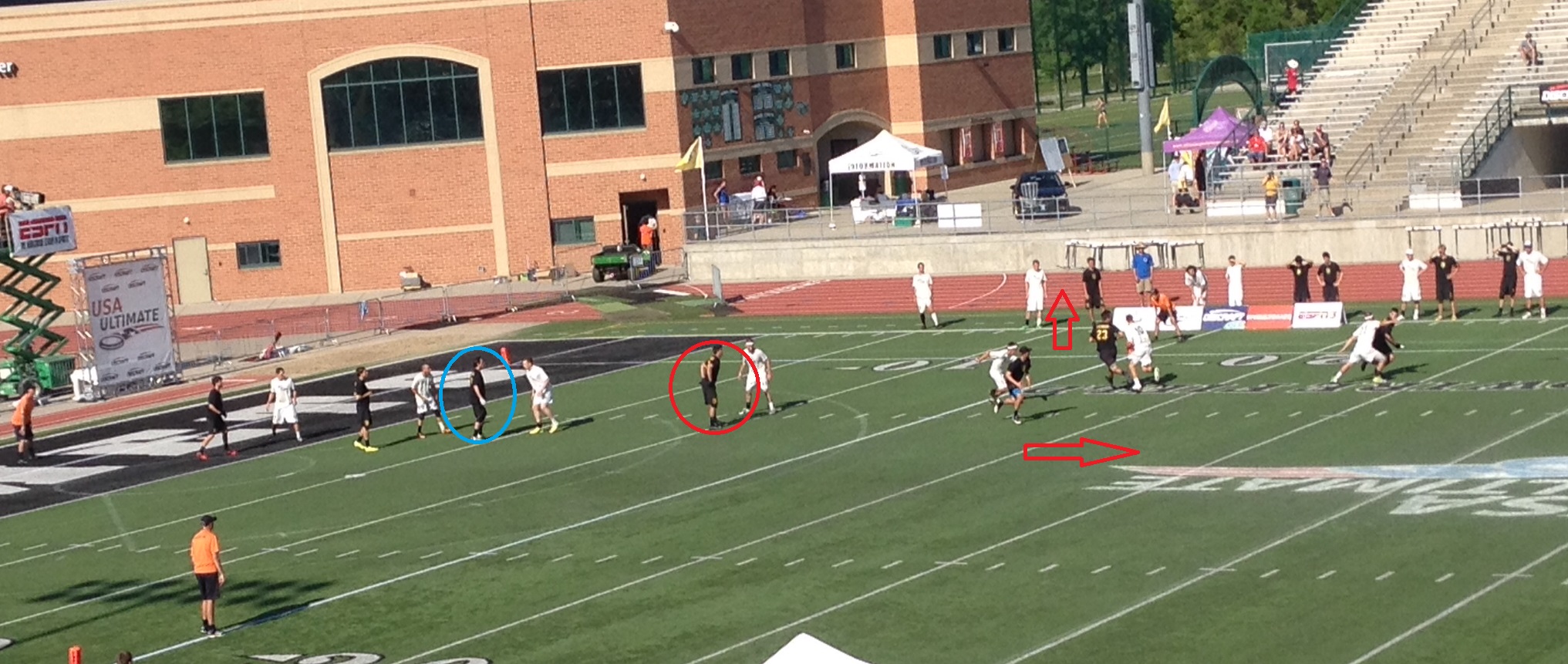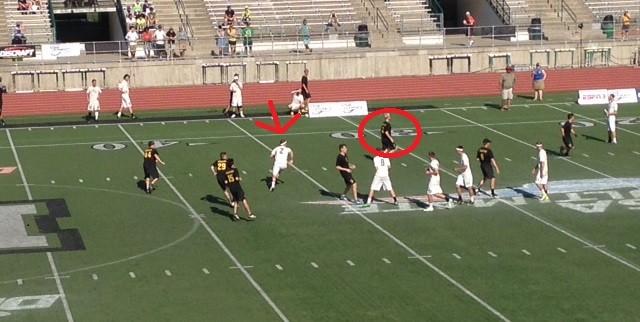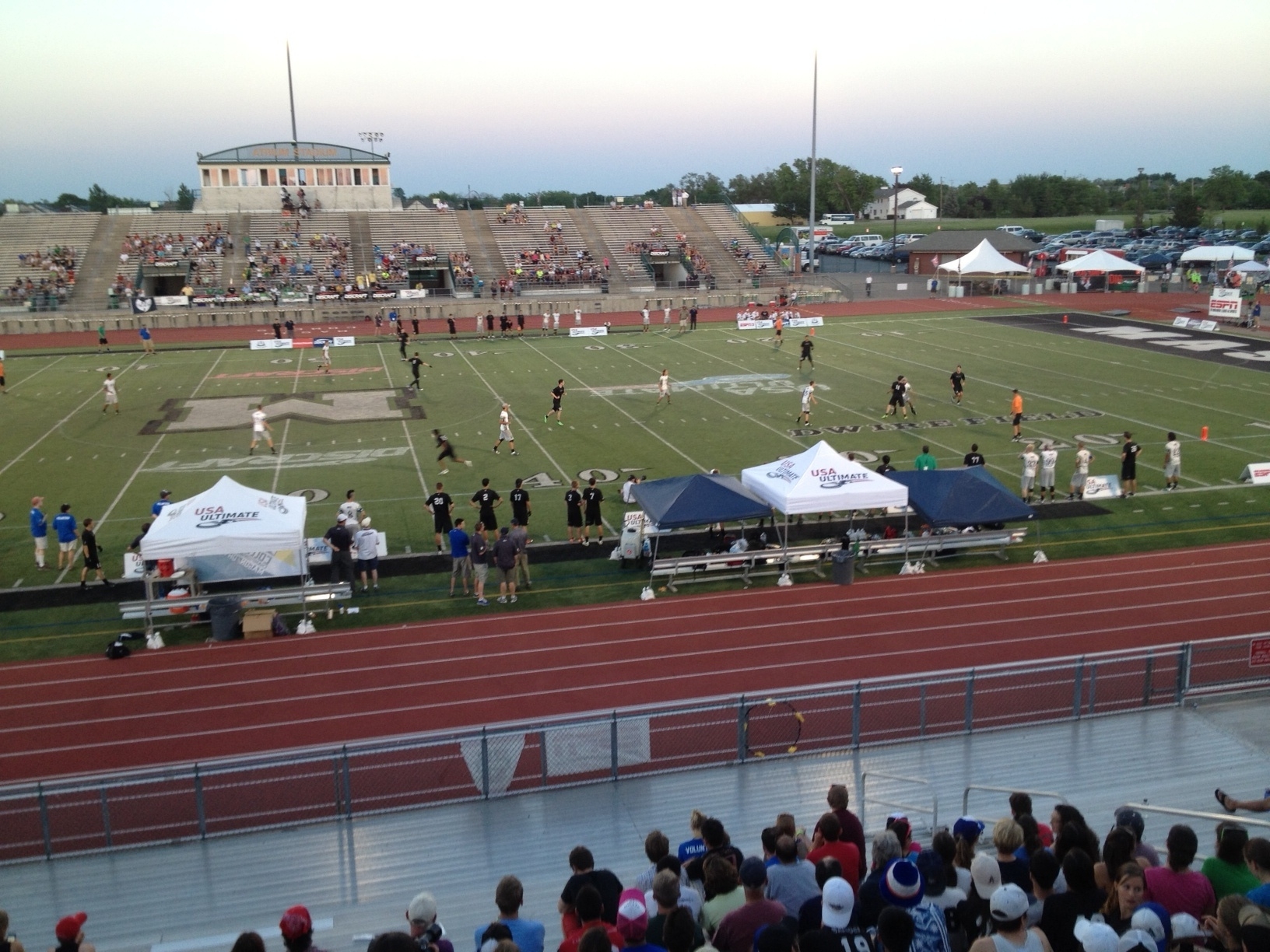“Discipline yourself, and others won’t need to.” – John Wooden Last night in the semifinals, it seemed like Colorado Mamabird and UNC Darkside advanced to the finals because they were the better teams. They were, no doubt the better teams in their matchups. But the success of Colorado and UNC wasn’t just about them being the better in their matchups. It was based in offensive discipline, based in one team behaving in one specific manner with the disc no matter what the opposition threw at them. That’s what was showcased when Colorado met Oregon, and North Carolina met UNC-Wilmington. And while we believe Oregon losing Gabe Fruchter to injury on the very first point of the game caused them to adjust their game plan, they were still not able to stop the disciplined offensive play of Colorado. Think about how much more strategy there is on the internet for ultimate now compared to say, five years ago. A whole lot more. And not just your run of the mill strategy, that’s laid out perfectly to implement with your summer team. But strategy based upon what the top teams in the nation are doing. Strategy that writers like those at Skyd, Ultiworld, and elsewhere can gather just by watching video on a specific team a few times. What is shown of the two finalists is that even in today’s video and internet age of ultimate, and through watching the two teams play a bunch previously, neither Oregon or Wilmington was able to disrupt these sets for more than a few points at a time. In the first semifinal, Colorado came out swinging, earning breaks with their trademark intense defense to get turns, while maintaining a precise, calm flow off of those turns to a quick 5-1 scoreline. Mamabird utilized the center stack nearly to perfection. Off a turned disc, Colorado would set a vertical stack in the middle of the field and send the front of the stack breakside and, if they did not immediately receive a break throw, immediately deep. Cuts from the back of the stack would simultaneously cut in to the force side open space. A fairly straight forward vertical stack that can be easily accounted for defensively, if everyone on the offensive side of the disc does not execute precisely. And that’s where Mamabird set themselves apart. It can be easy for players to ‘hang out’ on the break side, and not immediately go deep, clogging that entire side of the field, and making the space on the open side harder to find because the defense can see the clog and predict a throw away from it. It can be equally easy for handlers to clog this same space if the first few looks are covered. Colorado never let themselve succomb to these pitfalls, a testament to their coaching as much as each player’s recognition on the field. To the surprise of no one, it all spawned from the play of Mickle, whose cuts were precise and whose decision making was nearly always correct all game long.  The final key to Colorado’s success was their dedication to spacing in the vertical stack. Whether it was set up from a pull, or on the end zone line, Colorado always kept their vertical stack well spaced, not to compressed, not too wide. Oregon had issues with this throughout the game, making their offense sputter at times. You can see the difference in spacing in the above images. In the top image, Colorado maintains exactly 5 yards of space between cutters in the stack, as well as between handlers. Immediate and decisive motion from their handlers (noted with arrows in the top image) opened the entire field up for the front cut out of the vertical stack (circled in red). Especially note the spacing between cutters #1 and #2 (circled in blue) in the end zone. This 5 yard spacing allows full field options for the #1 cutter without the threat of poaches.
The final key to Colorado’s success was their dedication to spacing in the vertical stack. Whether it was set up from a pull, or on the end zone line, Colorado always kept their vertical stack well spaced, not to compressed, not too wide. Oregon had issues with this throughout the game, making their offense sputter at times. You can see the difference in spacing in the above images. In the top image, Colorado maintains exactly 5 yards of space between cutters in the stack, as well as between handlers. Immediate and decisive motion from their handlers (noted with arrows in the top image) opened the entire field up for the front cut out of the vertical stack (circled in red). Especially note the spacing between cutters #1 and #2 (circled in blue) in the end zone. This 5 yard spacing allows full field options for the #1 cutter without the threat of poaches.  Conversely, in the second image you can see Oregon setting up a center stack that is too compressed off a pull. Because of this, Colorado’s Oak Nelson (circled) can stay as a poach in the lane before heading to his assignment on the furthest handler backfield. This disrupts the offensive flow just enough for Colorado to get a turn after an ill-advised throw into the previously poached space. Like their opponents in the final tomorrow, UNC ran a more strict offense than their opponent, UNC-W, both horizontal and vertical. To begin the game, UNC would look to hit Johnson or Nethercutt deep after 1-2 completed under cuts. Their superior athleticism allowed for Nethercutt and the UNC Callahan nominee Johnson to find space to get open on these early deep cuts. UNC-W and UNC know each other very well, and Wilmington did not take long to react to UNC’s offense. Like any good team does, North Carolina then adjusted to the defensive adjustment by Wilmington. In the point immediately before halftime and in the second half UNC would run the same offensive sets, but this time when Wilmington would take steps to anticipate the deep shots, UNC would have another cut come under on either the open or break side for easy gainers. Now, on the other side of the coin, what did Oregon and Wilmington do to try and disrupt the discipline of their opponents? As mentioned earlier, they were each able to cause some chaos with their defensive sets in fleeting instances. But nothing lasting, nothing that helped either team climb back into the game after finding themselves down by a few breaks. For Oregon, one of their key strategies seemed to be trying to make Jimmy Mickle’s time on the field a living hell when Mamabird had the disc. They did this by putting Dylan Freechild on Mickle in all opportunities – off of timeouts, when Oregon would turn the disc over, and off of the pull. In the second point of the game, Freechild was able to knock down an inside break throw to Jimmy off of a timeout. But Mamabird was able to adjust for this. Primarily by moving Mickle back as one of the handlers on offense, and letting one of the other cutters on Colorado carry the workload. For instance, when it was 12-7 Mamabird, they set in a vertical stack and Oregon’s defense came out with strong man defense – very close to the bodies of the cutters and handlers, hips positioned well, and in general just more ready in our eyes – and at first they seemed to stymie the offensive possession. But to respond, Colorado sent Mickle to the force side, drawing with him his defender and hesitant moves by the rest of the defenders in the stack for an easy breakside cut and reception, and the disc was continually worked in their usual fashion for the score. Oregon also tried a zone look, but that too was able to picked apart in similar fashion by Colorado. Lastly, we noticed that one of the many reasons the Mamabird cutters were able to continually get open is that they didn’t let each other ‘dance’ when cutting – particularly near the endzone. It was one or two cuts, and if you didn’t receive the disc you were out and Colorado moved the disc with a dump swing. Again, even through any adversity placed on their offense by Oregon, Colorado stayed disciplined and were able to dominate the game. On Mamabird’s defense, they had a few specific strategies to stop Oregon’s offense – but again, not sure what would’ve changed had Fruchter not been injured for Ego. As Oregon did to them, Colorado really relied on hard man defense from their downfield defenders. This pressure caused turnovers for Ego early in the game. Occasionally for the handler defenders, they would jump off of the handlers and into the lanes, which helped generate turns for them as well. Ego also made mental mistakes of their own, but with the strong discipline of Mamabird’s offense no matter who was in – this was even evident on the last point of the game when the depth players were running the offense – any chance to score was typically capitalized on.
Conversely, in the second image you can see Oregon setting up a center stack that is too compressed off a pull. Because of this, Colorado’s Oak Nelson (circled) can stay as a poach in the lane before heading to his assignment on the furthest handler backfield. This disrupts the offensive flow just enough for Colorado to get a turn after an ill-advised throw into the previously poached space. Like their opponents in the final tomorrow, UNC ran a more strict offense than their opponent, UNC-W, both horizontal and vertical. To begin the game, UNC would look to hit Johnson or Nethercutt deep after 1-2 completed under cuts. Their superior athleticism allowed for Nethercutt and the UNC Callahan nominee Johnson to find space to get open on these early deep cuts. UNC-W and UNC know each other very well, and Wilmington did not take long to react to UNC’s offense. Like any good team does, North Carolina then adjusted to the defensive adjustment by Wilmington. In the point immediately before halftime and in the second half UNC would run the same offensive sets, but this time when Wilmington would take steps to anticipate the deep shots, UNC would have another cut come under on either the open or break side for easy gainers. Now, on the other side of the coin, what did Oregon and Wilmington do to try and disrupt the discipline of their opponents? As mentioned earlier, they were each able to cause some chaos with their defensive sets in fleeting instances. But nothing lasting, nothing that helped either team climb back into the game after finding themselves down by a few breaks. For Oregon, one of their key strategies seemed to be trying to make Jimmy Mickle’s time on the field a living hell when Mamabird had the disc. They did this by putting Dylan Freechild on Mickle in all opportunities – off of timeouts, when Oregon would turn the disc over, and off of the pull. In the second point of the game, Freechild was able to knock down an inside break throw to Jimmy off of a timeout. But Mamabird was able to adjust for this. Primarily by moving Mickle back as one of the handlers on offense, and letting one of the other cutters on Colorado carry the workload. For instance, when it was 12-7 Mamabird, they set in a vertical stack and Oregon’s defense came out with strong man defense – very close to the bodies of the cutters and handlers, hips positioned well, and in general just more ready in our eyes – and at first they seemed to stymie the offensive possession. But to respond, Colorado sent Mickle to the force side, drawing with him his defender and hesitant moves by the rest of the defenders in the stack for an easy breakside cut and reception, and the disc was continually worked in their usual fashion for the score. Oregon also tried a zone look, but that too was able to picked apart in similar fashion by Colorado. Lastly, we noticed that one of the many reasons the Mamabird cutters were able to continually get open is that they didn’t let each other ‘dance’ when cutting – particularly near the endzone. It was one or two cuts, and if you didn’t receive the disc you were out and Colorado moved the disc with a dump swing. Again, even through any adversity placed on their offense by Oregon, Colorado stayed disciplined and were able to dominate the game. On Mamabird’s defense, they had a few specific strategies to stop Oregon’s offense – but again, not sure what would’ve changed had Fruchter not been injured for Ego. As Oregon did to them, Colorado really relied on hard man defense from their downfield defenders. This pressure caused turnovers for Ego early in the game. Occasionally for the handler defenders, they would jump off of the handlers and into the lanes, which helped generate turns for them as well. Ego also made mental mistakes of their own, but with the strong discipline of Mamabird’s offense no matter who was in – this was even evident on the last point of the game when the depth players were running the offense – any chance to score was typically capitalized on.  Meanwhile, Wilmington employed a junk-zone defense to stop the hucks that seemed to consistently open up on offense for North Carolina. Right before halftime, when the score was 7-6 North Carolina, Wilmington ran this zone look (above in white) and at first was able to generate a turn. But Darkside realized that if they work the handlers back and forth hard enough – in the picture, Christian Johnson is back for this purpose as well – the middle players in this zone come in which opens up space between them and the deeps. Wilmington wasn’t able to run the zone very much as a result of this strong play by Darkside to exploit the holes in this look. Aside from the zone look, the Seamen chose man defense on North Carolina and it simply wasn’t working – for many of the reasons outlined above. There were still defensive bids for the disc, and a lot of close calls as a result, but nothing that was able to consistently generate turns for Wilmington to climb back into the game.
Meanwhile, Wilmington employed a junk-zone defense to stop the hucks that seemed to consistently open up on offense for North Carolina. Right before halftime, when the score was 7-6 North Carolina, Wilmington ran this zone look (above in white) and at first was able to generate a turn. But Darkside realized that if they work the handlers back and forth hard enough – in the picture, Christian Johnson is back for this purpose as well – the middle players in this zone come in which opens up space between them and the deeps. Wilmington wasn’t able to run the zone very much as a result of this strong play by Darkside to exploit the holes in this look. Aside from the zone look, the Seamen chose man defense on North Carolina and it simply wasn’t working – for many of the reasons outlined above. There were still defensive bids for the disc, and a lot of close calls as a result, but nothing that was able to consistently generate turns for Wilmington to climb back into the game.









Comments Policy: At Skyd, we value all legitimate contributions to the discussion of ultimate. However, please ensure your input is respectful. Hateful, slanderous, or disrespectful comments will be deleted. For grammatical, factual, and typographic errors, instead of leaving a comment, please e-mail our editors directly at editors [at] skydmagazine.com.